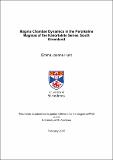Files in this item
Magma chamber dynamics in the peralkaline magmas of the Kakortokite Series, South Greenland
Item metadata
| dc.contributor.advisor | Finch, Adrian Anthony | |
| dc.contributor.advisor | Donaldson, C. H. | |
| dc.contributor.author | Hunt, Emma J. | |
| dc.coverage.spatial | viii, 214, [7] p. | en_US |
| dc.date.accessioned | 2015-07-03T09:11:45Z | |
| dc.date.available | 2015-07-03T09:11:45Z | |
| dc.date.issued | 2015-03-30 | |
| dc.identifier | uk.bl.ethos.655451 | |
| dc.identifier.uri | https://hdl.handle.net/10023/6900 | |
| dc.description.abstract | Understanding crystallisation in magma chambers is a key challenge for igneous petrology. It is particularly important to understand the origins of layering in peralkaline rocks, e.g. the kakortokite (nepheline syenite), Ilímaussaq Complex, S. Greenland, as these are commonly associated with high value multi-element economic deposits. The kakortokite is a spectacular example of macrorhythmic (>5 m) layering. Each unit consists of three layers comprising arfvedsonite-rich (sodic-amphibole) black kakortokite at the base, grading into eudialyte-rich (sodic-zirconosilicate) red kakortokite, then alkali feldspar- and nepheline-rich white kakortokite. Each unit is numbered -19 to +17 relative to a characteristic well-developed horizon (Unit 0), however there is little consensus on their development. This project applies a multidisciplinary approach through field observations combined with petrography, crystal size distributions (CSDs), mineral and whole rock chemistries on Units 0, -8 to -11 and a phonolite/micro-nephelinolite (“hybrid”) sequence that crosscuts the layered kakortokite. Textures and compositions are laterally consistent across outcrop and indicators of current activity are rare. CSDs indicate in situ crystallisation with gravitational settling as a minor process. Chemical discontinuities occur across unit boundaries. The layering developed through large-scale processes under exceptionally quiescent conditions. The discontinuities reflect open-system behaviour; units were formed by an influx of volatile-rich magma that initiated crystallisation in a bottom layer. Nucleation was initially suppressed by high volatile element concentrations, which decreased to allow for crystallisation of arfvedsonite, followed by eudialyte, then alkali feldspar and nepheline to form each tripartite unit. The chemistry of the hybrid indicates mixing between a primitive (sub-alkaline) magma and kakortokite. Thus injections of magmas of varying compositions occurred, indicating a complex plumbing system below current exposure. The lessons learned at Ilímaussaq, which is extremely well exposed and preserved, are relevant to understanding magma chamber dynamics in the more common instances of pervasively altered peralkaline rocks. | en_US |
| dc.language.iso | en | en_US |
| dc.publisher | University of St Andrews | en |
| dc.subject | Ilímaussaq Complex | en_US |
| dc.subject | Kakortokite | en_US |
| dc.subject | Peralkaline | en_US |
| dc.subject | Agpaitic | en_US |
| dc.subject | Nepheline syenite | en_US |
| dc.subject | Eudialyte | en_US |
| dc.subject | Rare earth elements | en_US |
| dc.subject | Economic geology | en_US |
| dc.subject | Mineralogy | en_US |
| dc.subject | Petrology | en_US |
| dc.subject | Macrorhythmic layering | en_US |
| dc.subject | Oscillatory crystallisation | en_US |
| dc.subject | Volatile activities | en_US |
| dc.subject | Crystal size distributions | en_US |
| dc.subject | Igneous textures | en_US |
| dc.subject | In situ crystallisation | en_US |
| dc.subject.lcc | QE601.H86 | |
| dc.subject.lcsh | Geology--Greenland | en_US |
| dc.subject.lcsh | Nepheline syenite | en_US |
| dc.subject.lcsh | Mineralogy | en_US |
| dc.subject.lcsh | Petrology | en_US |
| dc.subject.lcsh | Igneous rocks | en_US |
| dc.title | Magma chamber dynamics in the peralkaline magmas of the Kakortokite Series, South Greenland | en_US |
| dc.type | Thesis | en_US |
| dc.contributor.sponsor | Natural Environment Research Council (NERC) | en_US |
| dc.type.qualificationlevel | Doctoral | en_US |
| dc.type.qualificationname | PhD Doctor of Philosophy | en_US |
| dc.publisher.institution | The University of St Andrews | en_US |
This item appears in the following Collection(s)
Items in the St Andrews Research Repository are protected by copyright, with all rights reserved, unless otherwise indicated.


